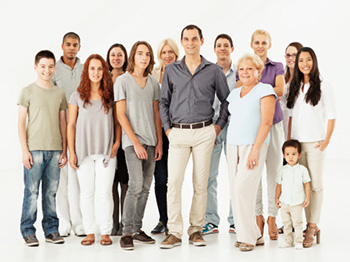 Think about how different one person looks compared to another. They are the same species, but their hair and eye color may differ and their noses and mouths are shaped differently. They both have arms and legs and chests and backs--these differ much less between people. Why do people look so different from each other? Why do some parts look more different than others?
Think about how different one person looks compared to another. They are the same species, but their hair and eye color may differ and their noses and mouths are shaped differently. They both have arms and legs and chests and backs--these differ much less between people. Why do people look so different from each other? Why do some parts look more different than others?
A lot of these differences in appearance (phenotypic variation) are influenced by environmental factors--what someone eats, how much sun a person gets, whether they smoke, and a lot of it is influenced by the person’s genotype (the DNA in their cells). These factors constantly interact so that an individual’s phenotype is a result of their environment and genotype. Some traits that are completely determined by genotype vary considerably between individuals, but others do not. Why is this? Don’t we all have the same genes? Watch the video below to learn more about genotypic variation.
![]() The DNA inside of the nucleus of the cell contains all of the genetic information the body needs. Each chromosome contains certain genes which lead to expression of specific traits. For each gene, there are two or more variations called alleles. These alleles are located in the same position on the chromosome.
Sometimes, new alleles form. This occurs through random mutations. Here, the DNA double helix is unwinding then unzipping into its two complementary strands. DNA is formed of two sugar-phosphate strands, which are showin in grey. These strands are linked by pairs of bases: adenine binds with thymine, and guanine binds with cytosine. The sequence of bases along the strands forms a template for the production of proteins. The change from T to A seen here is a point mutation, and can lead to a different amino acid being incorporated into the intended protein, often significantly changing its properties.
Mutations can show themselves as changes in the expressed traits of a population. The finches that expressed different beak shapes and sizes that Darwin recognized is an example of this. As random mutations occurred in the genes that determine beak shape and size, some led to phenotypes that were advantageous. Those animals were able to survive and reproduce more readily than others.
If you studied the alleles of these finches historically, you would notice that there were changes from generation to generation. Those birds that were stronger and more successful reproducers carried the mutated and advantageous genes forward.
So, within every population is genetic variation caused by different alleles that are expressed, as well as mutations that find their way into the population through environmental pressures.
The DNA inside of the nucleus of the cell contains all of the genetic information the body needs. Each chromosome contains certain genes which lead to expression of specific traits. For each gene, there are two or more variations called alleles. These alleles are located in the same position on the chromosome.
Sometimes, new alleles form. This occurs through random mutations. Here, the DNA double helix is unwinding then unzipping into its two complementary strands. DNA is formed of two sugar-phosphate strands, which are showin in grey. These strands are linked by pairs of bases: adenine binds with thymine, and guanine binds with cytosine. The sequence of bases along the strands forms a template for the production of proteins. The change from T to A seen here is a point mutation, and can lead to a different amino acid being incorporated into the intended protein, often significantly changing its properties.
Mutations can show themselves as changes in the expressed traits of a population. The finches that expressed different beak shapes and sizes that Darwin recognized is an example of this. As random mutations occurred in the genes that determine beak shape and size, some led to phenotypes that were advantageous. Those animals were able to survive and reproduce more readily than others.
If you studied the alleles of these finches historically, you would notice that there were changes from generation to generation. Those birds that were stronger and more successful reproducers carried the mutated and advantageous genes forward.
So, within every population is genetic variation caused by different alleles that are expressed, as well as mutations that find their way into the population through environmental pressures.
Because genes evolve at different rates within and between populations, it is important to know that when we refer to an allele in this lesson, we are focusing on only one gene in one population. In other words, each time you see the word allele, you can always add of a particular gene in a particular population.
Question
Does evolution or natural selection make genes change?
